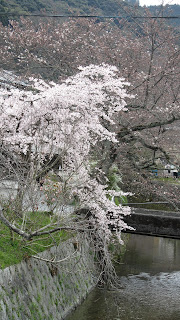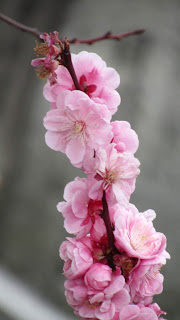Despite the fact that daily life in Japan shows absolutely
no sign of this being the Easter weekend – I encountered God in a Shinto
shrine.
Amy tells me that modern Japanese people see themselves
as a secular society. So I did some research, and found that their history is a
combination of Shinto and Buddhism. We have visited both Buddhist temples and Shinto shrines.
Some are placed magnificently on top of hills, while others are tucked away
alongside bustling city roads.
I also discovered that the Emperor Meiji found Shinto to be a useful tool to unify Japan. He made Shinto the official religion, known as State Shinto, with shrines under government control. Later, during World War Two, Japanese nationalism required everyone to participate in State Shinto and accept the Emperor as divine. After the war, the shrines were taken out of government control, and State Shinto was abolished
It seems that since then, organized
religious participation has declined, Japanese society has become secular, and
religious study in general has become less important. Perhaps this is a
reaction to the state using the religious sentiments of the people for
political purposes. What we have observed, however, is that the people are
still spiritual. The shrines all have fresh flowers, the temples have burning candles
and incense, and there is a steady stream of people visiting their holy places to
offer prayers.
Which brings me to my
God-moment. Yesterday – Easter Saturday - Amy took us to visit a local Shinto Shrine in Sasayama. It is called Ojiyama makekirai inari. This can be loosely translated as “hate to lose”, which indicates that this is a place to pray for victory. Many students come here to pray for success in examinations. We climbed the rows and rows of stairs up the hill towards the shrine at the top. They are intended to slow a person down, to allow us to pause, and breathe, and think. And they do.
Jenny and I were taking pictures, and enjoying the sense
of leaving the noise of the town and entering a tree-lined sanctuary, when things
changed for me. I found myself standing in front of a shrine just to the left,
and below, the main shrine. And I lost my desire to take more photographs, or
to talk, or to do anything other than stand in silence. I had this sense that
God was enveloping me. I knew that I was loved, and I stood rooted to the spot in
silent awe. After a while I found one of the candles placed in front of the
shrine and lighted it in reverence for this moment of peace.
As I stepped back
I saw that the shrine was crowned with a cross. I do not have a clue what symbolism
was intended by those who built this shrine – but this was my Easter place. I
prayed at the foot of this cross, and my spirit was renewed. Jenny and Amy
joined me in lighting candles, and there was really no need for words. We worshipped
God.
 |
| Ojiyama makekirai inari |












